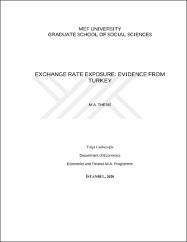Please use this identifier to cite or link to this item:
https://hdl.handle.net/20.500.11779/2102| Title: | Exchange Rate Exposure: Evidence From Turkey |
| Other Titles: | Döviz kuru riski: Türkiye örneği |
| Authors: | Canbazoğlu, Tolga |
| Advisors: | Toraganlı Karamollaoğlu, Nazlı |
| Keywords: | Ekonometri Econometrics Ekonomi |
| Publisher: | MEF Üniversitesi |
| Source: | Canbazoğlu, T. (2020). Exchange rate exposure: Evidence from Turkey = Döviz kuru riski: Türkiye örneği, MEF Üniversitesi, Sosyal Bilimler Enstitüsü, İktisat Ana Bilim Dalı, ss. 1-67 |
| Abstract: | Bu tez çalışması, 2010-2019 yılları arasında Borsa İstanbul'da işlem gören 330 firmanın finansal tablolarına dayanarak kurdaki dalgalanmanın şirketlerin hisse senedi getirileri üzerindeki etkilerini ölçmeyi amaçlamaktadır. Bu çalışmada, döviz kuru riski Adler ve Dumas (1984) yöntemine göre firmaların sektörlere bölünmesiyle analiz edilmiştir. Baz modele göre, döviz kuru katsayısı, 26 sektörden 8'inde anlamlı görülmektedir, genişletilmiş model için 26 sektörden 6'sında katsayı anlamlıdır. Ayrıca çalışmada şirketleri, tercih edilebilir ve edilmez likidite, finansal, karlılık ve ciro oranlarına göre kategorilere ayırarak bu iki gruptaki döviz kuru riski ölçülmektedir. Rasyo analizlerinin sonuçları olumlu ve olumsuz seviyede rasyo oranlarına sahip şirketler için döviz kuru riski aynı şekilde tutarlı olarak rapor etmemektedir. Stokların toplam varlıklara oranı, kaldıraç, faiz giderlerinin satışa ve yabancı varlıkların toplam borçlara oranı tercih edilen seviyede olan şirketler ve nakit, likidite, alacak devir hızı tercih edilmeyen seviyede olan firmalar kur hareketlerine maruz kalmaktadır. Ayrıca, farklı ihracat seviyelerine sahip firmalar kur değişimlerinden farklı şekilde etkilenmemektedir. This thesis study aims to measure effects of the fluctuation in the exchange rate on companies' stock returns based on financial statements of 330 firms that were traded on Borsa Istanbul between 2010 and 2019. In this study, exchange rate exposure was analyzed by dividing the firms into sectors based on the methodology of Adler and Dumas (1984) According to the baseline model, the coefficient of exchange rate appears as significant in 8 of 26 sectors for the extended model the coefficients are significant in 6 of 26 sectors. I further categorize firms based on favorable and unfavorable levels of liquidity, financial, profitability and turnover ratios, and measure exchange rate exposure across the two groups of firms. The results of the ratio analysis are mixed. Firms with favorable levels of inventory to total asset, leverage, interest expense to sales, and foreign assets to total debt ratio and unfavorable levels of cash, liquidity, receivable turnover ratio are exposed to exchange rate movements. Moreover, firms with different export levels are not affected differently by exchange rate variations. |
| URI: | https://tez.yok.gov.tr/UlusalTezMerkezi/TezGoster?key=_F5QEpayDXGqGZlp9XiFtOWlPSKGfV-4j97pvvHUn_uSW96RzDhb0Hr9CPV2ae5i https://hdl.handle.net/20.500.11779/2102 |
| Appears in Collections: | SBE - Yüksek Lisans - Tez Koleksiyonu |
Files in This Item:
| File | Description | Size | Format | |
|---|---|---|---|---|
| EXCHANGE RATE EXPOSURE EVIDENCE FROM TURKEY.pdf | Tez Dosyası | 2.09 MB | Adobe PDF |  View/Open |
CORE Recommender
Sorry the service is unavailable at the moment. Please try again later.
Items in GCRIS Repository are protected by copyright, with all rights reserved, unless otherwise indicated.